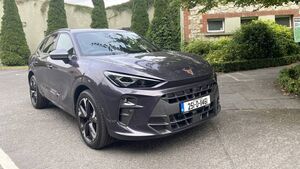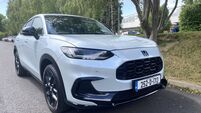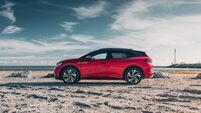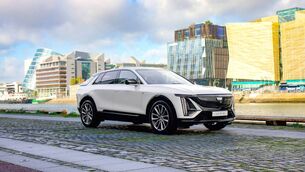Cupra Terramar has performance and style

The exterior design includes a shark-nose-inspired front, athletic proportions emphasised by the long bonnet, sports bumpers, and strong rear end with 3D LED lights and illuminated Cupra logo.
Cupra has gained a lot of recognition in Ireland in recent years with its line-up of performance-focused sporty cars. This has paid off with increased sales figures year-on-year.
My latest Cupra test drive was in the Terramar compact SUV, launched here at the end of last year and described by the brand as their best hybrid SUV yet. It shares underpinnings with the VW Tiguan.
Terramar has a strong and distinctive, even intimidating, exterior design that looks different to most of its mainstream competitors but is a practical and sporty family car, slightly larger in size than its Formentor SUV sibling. To me, it looks simply gorgeous from every angle.
The exterior design includes a shark-nose-inspired front, athletic proportions emphasised by the long bonnet, sports bumpers, and strong rear end with 3D LED lights and illuminated Cupra logo. Roof rails are standard. An option is the 19-inch machined alloy wheels in Sport Black Matt finish. I really like Cupra’s trademark copper-coloured accents on the exteriors and interiors of their cars, which always lift the look. The copper-coloured logo is instantly recognisable to car fans.
High door openings make it easy for tall people to get in and out and mean they don’t have to duck their heads in the process.
The upmarket cabin is comfy and spacious with some nice quality materials and a good balance of copper-coloured detailing. But I’m not a fan of the grey fish-scale-like patterned plastic on the central spine - it looks cheap - or of the blue and grey colour scheme and black roof lining. Too dismal looking.
The freestanding 12.9-inch infotainment touchscreen angled towards the driver is user-friendly, offering navigation, entertainment, wireless Apple CarPlay and Android Auto, and voice control via Cupra Connect. The 10.25-inch digital instrument cluster works with the head-up display on the windscreen. You can customise the cluster via the View button on the steering wheel to show your current speed large in a central dial, by default it shows bottom right on the screen.
Blue or red lines on the bottom of the central screen are for the dual-zone climate control, and the white lines in between are for volume control. All are easy to work with while on the go.
Sporty bucket seats made from sustainable materials have integrated headrests and manual seat adjustments, including lumbar support, but when I moved my seat forward for a good fit behind the wheel, the long seat cushion hurt me behind my knees. Taller people may not have this problem.
The leather multi-function sports steering wheel comes with two satellite buttons - one to start or stop the engine, the other to select your driving modes of Comfort, Normal, or Sport. The twisty gear selector is located off the steering wheel.
There's a wireless charging pad, two C-type USB ports, as well as big door bins, and a good bucket-shaped glovebox.
Rear seats can be moved back or forward depending on the amount of legroom needed. Boot space is up to 540 litres when they are moved forward. The boot has two adjustable height settings and a storage area below.
Trims are V1, V2 and VZ. Entry-level features include 18-inch alloys matt black/silver, black roof rails, rear-view camera, front and rear parking sensors, 3-zone climate control with air conditioning, front fog lamp with cornering control, and a rear wiper. The Blind Spot Alert, part of the lighting strip on front doors, lights up when a car is approaching from behind.
The V2 trim adds Adaptive Cruise Control, wraparound smart interior lighting, dark-tinted glass, front heated seats, and power tailgate. Options were the Dark Void special metallic paint, 19-inch alloys, an Edge Pack (power heated side mirrors, heated steering wheel, interior lighting, dark-tinted windows, electric tailgate and virtual pedal), Pure Performance (of Matrix HD lights and Dynamic Chassis Control), and Intelligent Drive (Intelligent Park Assist, Side and Exit Assist, Rear Traffic Alert, and top-view camera).
The model is available in petrol, mild hybrid (mHEV) and as a plug-in hybrid (PHEV). My car was the mHEV with 1.5e TSI 150hp and matched to a smooth-shifting 7-speed DSG automatic transmission and with a claimed fuel consumption of 8.1 L/100kms. Max torque is 250Nm and you have up to 1,000km available.
Other engines are a 2.0 TSI 204hp DSG 4WD and an eHybrid 204hp. Only two engines are offered with the VZ version: an eHybrid with 272hp and a 2.0 TSI 265hp 4Drive. There is no diesel.
On the road, I found the Terramar a lovely car to drive with good performance and also appreciated the smooth DSG transmission, but I found the engine quite noisy. As for annoying ‘driver alerts’, you can pull down a menu from the top of the screen to be able to manage any driver ‘assistance’ system you want to turn off.
With its array of safety features, Terramar achieved the maximum 5-star Euro NCAP safety rating scoring well across all categories.
PRICE: the entry-level model is from €46,500; my review car €53,240. Road tax is €210.






